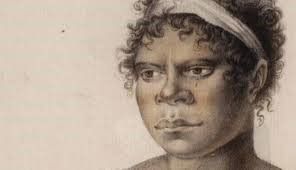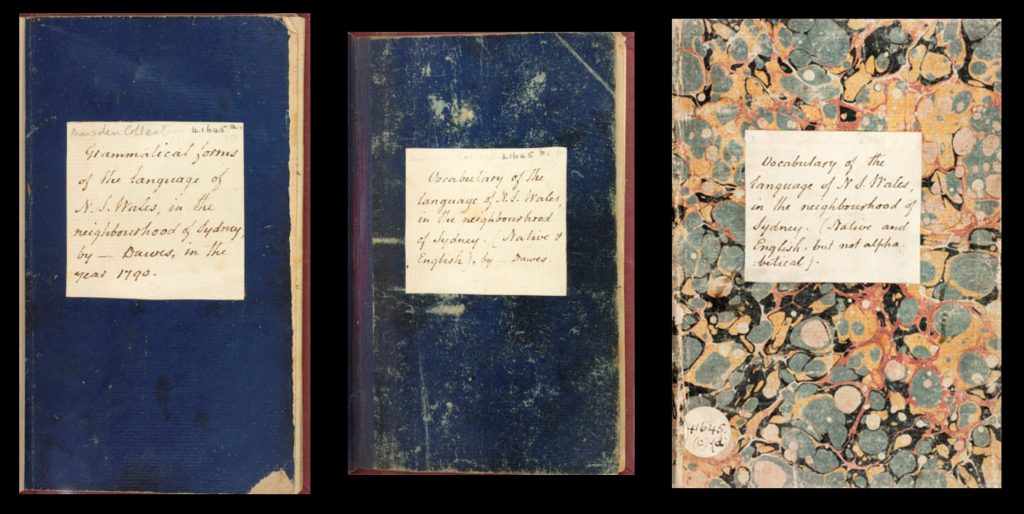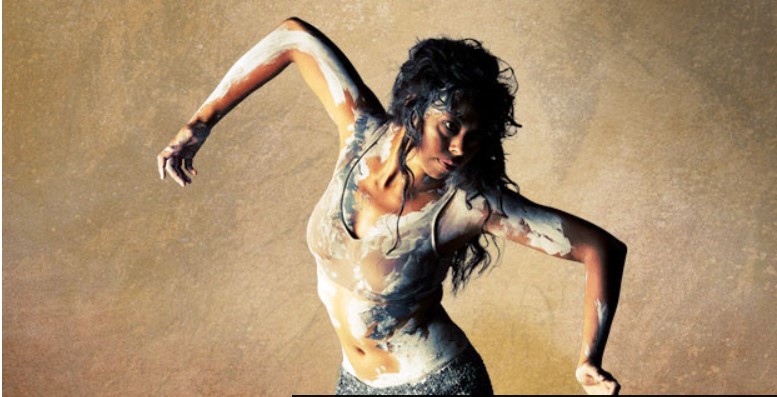
Image of a young Aboriginal woman, possibly Patyegarang [2].
Patyegarang was an Aboriginal woman living in the Sydney region at the arrival of the First Fleet in 1788, who played a significant role in early contact between Aboriginal and British people.
Patyegarang was both a confidant and teacher to William Dawes, a lieutenant who created what is now considered to be the first written account of the Aboriginal language of Sydney [1].
Her story has only recently come to light following the re-emergence of the language notebooks of William Dawes in London in 1972 [3]. Patyegarang is not mentioned in any of the other historical accounts of the First Fleet [4], so the little that is known about her life is based on what can be understood, or inferred, from Dawes’ notebooks.
William Dawes notebooks on the ‘Aboriginal Language of Sydney’, from 1790-1791 [5]
Patyegarang would have been around 15 years of age at the time she first met Dawes but according to historian and author of 26 Views of the Starburst World: William Dawes at Sydney Cove, Ross Gibson:
There is no doubt Patyegarang was remarkable. Young as she was, she was Dawes’ intellectual equal and she was not averse to carrying complex political messages to the British, even as she also negotiated the intricacies of her friendship with Dawes. [6]
Stephen Page, artistic director of Bangarra Dance Theatre, Australia’s leading indigenous performing arts company, who choreographed Patyegarang believes:
Patyegarang was a young woman of fierce and endearing audacity, and a ‘chosen one’, so to speak, within her clan and community. Her tremendous display of trust in Dawes resulted in a gift of cultural knowledge back to her people almost 200 years later and I feel her presence around us, with us as we create this new work. [7]
Patyegarang (Jasmin Sheppard) from Bangarra Dance Theatre’s 2014 production ‘Patyegarang’, photograph by Greg Barrett, courtesy Bangarra. [8]
‘Members of Aboriginal and Torres Strait Islander communities are advised that the this article contains images, names and stories of deceased peoples.’
Chrissie Crispin, Research Assistant – Work placement and Neera Sahni, Research Services Leader, Parramatta Heritage Centre, City of Parramatta 2018
References
[1] Nathan, D., Rayner, S., & Brown, S. (Eds.). (2009). William Dawes’ Notebooks on the Aboriginal Language of Sydney. London & Sydney: School of Oriental and African Studies (SOAS) & Darug Tribal Aboriginal Corporation. Retrieved on 18/06/18 from: http://www.williamdawes.org/index.html
[2] Observatory Hill Environmental Education Centre (2015). Colonial People, Places and Events. NSW Government Education & Communities. Retrieved 18/06/18 from http://observatoryhilleec.nsw.edu.au/primary-programs/barangaroo-stage-3/
[3] Bangarra Dance Theatre Australia. (2014). Patyegarang: A gift of Australian history in a remarkable dance experience about first contact. Walsh Bay: Bangarra Dance Theatre Australia. p.8. Retrieved on 18/06/18 from: https://www.bangarra.com.au/whatson/productions/patyegarang.
[4] Troy. J. [1992]. The Language Notebooks and responses to language contact in early colonial NSW. Originally printed in Australian Journal of Linguistics. 12. 145-170. Retrieved on 18/06/18 from: http://www.williamdawes.org/index.html
[5] Nathan, D., Rayner, S., & Brown, S. (Eds.). (2009). William Dawes’ Notebooks on the Aboriginal Language of Sydney. London & Sydney: School of Oriental and African Studies (SOAS) & Darug Tribal Aboriginal Corporation. Retrieved on 18/06/18 from: http://www.williamdawes.org/index.html
[6] Gibson, R. (2010). Patyegarang and William Dawes: the Space of Imagination. In Mar, T. B., & Edmonds, P. (Eds.). (2010) Making Settler Colonial Space: Perspectives on Race, Place and Identity. pp.242-254. London: Palgrave Macmillan Limited. Retrieved on 18/06/18 from: https://ebookcentral-proquest-com.ezproxy.csu.edu.au/lib/CSUAU/detail.action?docID=667954#.p.246.
[7] Bangarra Dance Theatre Australia. (2014). Patyegarang: A gift of Australian history in a remarkable dance experience about first contact. Walsh Bay: Bangarra Dance Theatre Australia. p.8. Retrieved on 18/06/18 from: https://www.bangarra.com.au/whatson/productions/patyegarang.
[8] City of Sydney. (2014). Patyegarang. Barani: Sydney’s Aboriginal History. Retrieved from: http://pandora.nla.gov.au/pan/24966/20160527-0011/www.sydneybarani.com.au/patyegarang/index.html
- Log in to post comments




